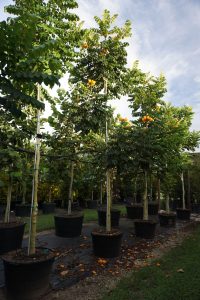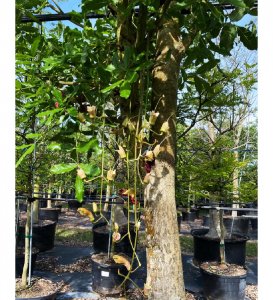Trees are primary providers of what is called environmental support or alternatively as environmental service. We define this as qualitative functions of assets related to: land, water, air and other plants and animals (biota). This role is similar in the wild and in a cultivated garden, but there are some differences; principally related to scale. Observing a wild landscape with trees or a tree- garden; environmental support is not obvious.
<h2>Root Systems</h2>
As , trees, through their root systems, anchor themselves in soil and rock, and in turn retard soil erosion; especially in hilly sites. Tree roots have a symbiotic relationship with soil mycorrhiza. Which is important because these fungi promote plant uptake of nutrients, water, phosphorus and nitrogen to support plant growth.
<h2>Environmental Support & Soil Fertility </h2>
Trees also contribute to soil fertility and health through their litter which microbes decompose; and convert into organic matter in the soil mix. Tree root growth also facilitates soil aeration for soil building. In terms of water, trees slow down surface runoff and allow more rainwater to percolate into the soil; to reach and recharge the water table. By holding more runoff water in the soil, trees also make more moisture available to themselves; and nearby vegetation types. A stand of trees also creates a microclimate under its canopy. Creating conditions which are typically cooler and moister than in surrounding more open areas.
Trees in their biomass represent carbon storehouses. Locking-up carbon removed as carbon dioxide from the atmosphere as part of photosynthesis; and giving off oxygen as a by-product. Thus trees play an important role in reducing CO2 in the atmosphere.
<h2>Tree Canopies </h2>
The shaded conditions beneath tree canopies create critical habitats for plants which cannot tolerate direct sunlight, and as sheltered environments required of wild terrestrial and arboreal animals, and pleasant conditions in which humans and domesticated animals can live. Vines, orchids Spanish moss and other similar vegetation forms require trees for support to enable them to complete their life cycles. Birds, certain species of bats, bees, wasps, butterflies and many insects depend upon trees for nesting and resting stations as they consume nectar, fruit flesh, seeds, and plant sugars from leaves, twigs and trunks.
It may be a stretch of meaning, but it could be advocated that beauty is a part of environmental support. True, some trees are ugly, even grotesque, but they are far outnumbered by trees possessing sublime beauty with respect to foliage, form, flowers and fruits. Many deciduous trees are beautiful even when their leaves have fallen and the intricate skeletal outline of the branching patterns becomes visible. Why does human society have such a fascination with and interest in landscaping with trees if not for the pleasure we derive from observing them, individually or in a mixed plantings of complementary species? In addition to the inherent beauty of ornamental trees in landscape plantings, cultivated plantations of the same species of commercial fruit tree, set out at fixed intervals in straight rows, all the trees strikingly similar, present a pleasing visual experience.






